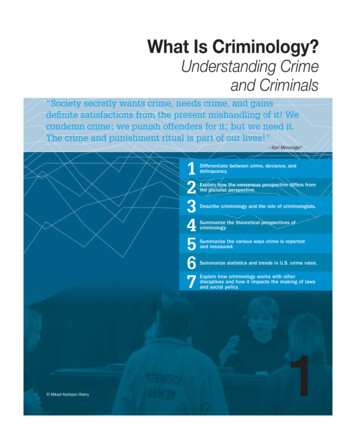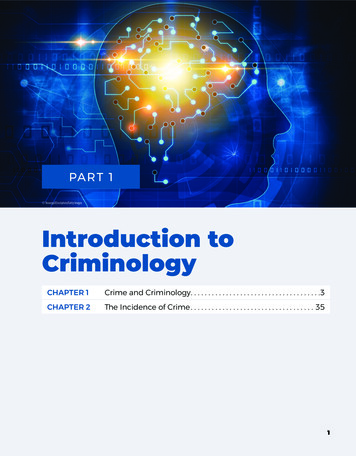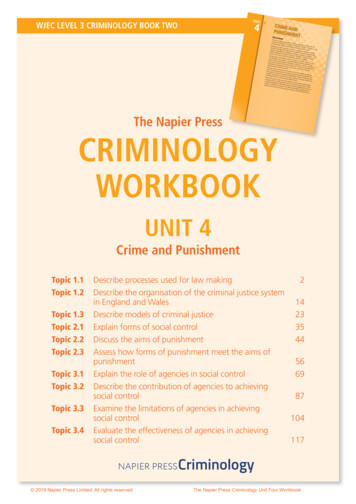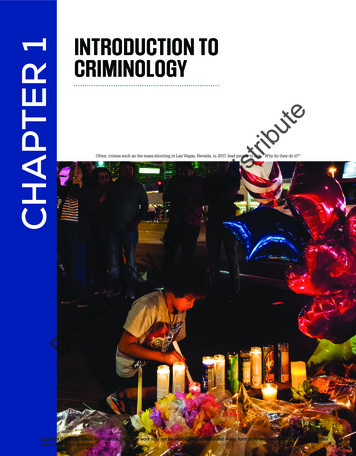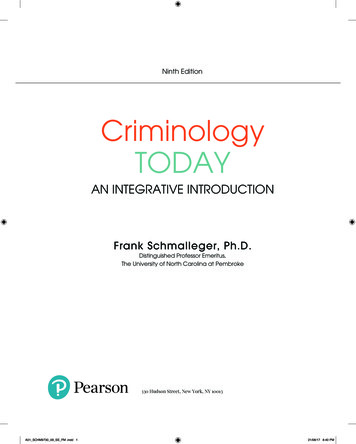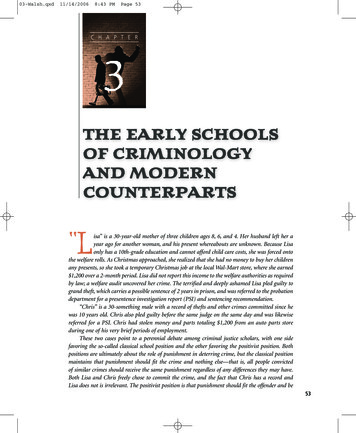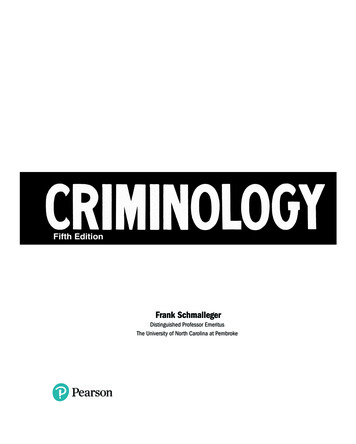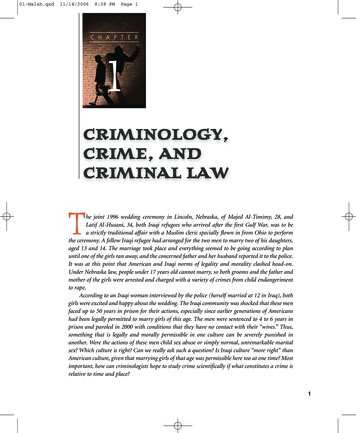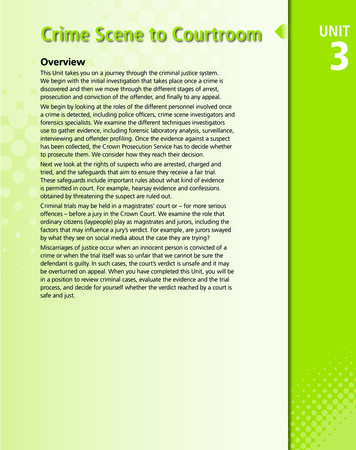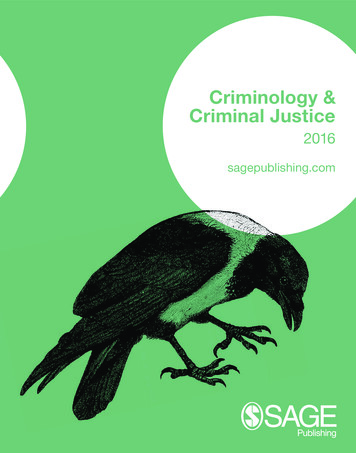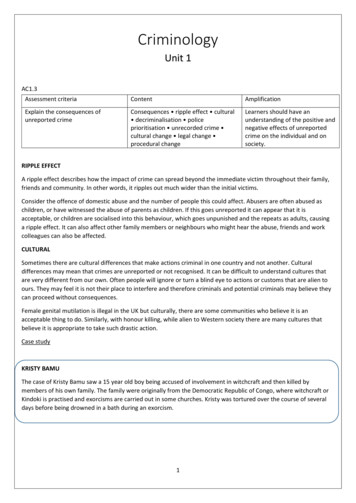
Transcription
CriminologyUnit 1AC1.3Assessment criteriaContentAmplificationExplain the consequences ofunreported crimeConsequences ripple effect cultural decriminalisation policeprioritisation unrecorded crime cultural change legal change procedural changeLearners should have anunderstanding of the positive andnegative effects of unreportedcrime on the individual and onsociety.RIPPLE EFFECTA ripple effect describes how the impact of crime can spread beyond the immediate victim throughout their family,friends and community. In other words, it ripples out much wider than the initial victims.Consider the offence of domestic abuse and the number of people this could affect. Abusers are often abused aschildren, or have witnessed the abuse of parents as children. If this goes unreported it can appear that it isacceptable, or children are socialised into this behaviour, which goes unpunished and the repeats as adults, causinga ripple effect. It can also affect other family members or neighbours who might hear the abuse, friends and workcolleagues can also be affected.CULTURALSometimes there are cultural differences that make actions criminal in one country and not another. Culturaldifferences may mean that crimes are unreported or not recognised. It can be difficult to understand cultures thatare very different from our own. Often people will ignore or turn a blind eye to actions or customs that are alien toours. They may feel it is not their place to interfere and therefore criminals and potential criminals may believe theycan proceed without consequences.Female genital mutilation is illegal in the UK but culturally, there are some communities who believe it is anacceptable thing to do. Similarly, with honour killing, while alien to Western society there are many cultures thatbelieve it is appropriate to take such drastic action.Case studyKRISTY BAMUThe case of Kristy Bamu saw a 15 year old boy being accused of involvement in witchcraft and then killed bymembers of his own family. The family were originally from the Democratic Republic of Congo, where witchcraft orKindoki is practised and exorcisms are carried out in some churches. Kristy was tortured over the course of severaldays before being drowned in a bath during an exorcism.1
Task:While watching the following documentary, take notes that amplify the case study of Kristy Bamu – an example ofcultural reasons for crime.https://www.youtube.com/watch?v nAzxkp1nJj0DECRIMINALISATIONLaws are frequently altered because they cannot be imposed or enforced. For example, the use of cannabis can bequite open in some places in the UK, because the police choose to act. Eventually, the government has little choicebut to decriminalise such offences because it has to accept that the criminal act cannot be controlled becausepeople no longer take notice of the law. When crimes go unreported, often it is due to the lack of public concern andinterest, or because it is seen as a victimless crime. This includes: DrugsProstitutionIllegal downloadsSuch actions are common, widespread crimes that people do not see as real offences so publically they becomedecriminalised. Although there are still laws against them, the punishments have been reduced, and less time andmoney are spent trying to find perpetrators of these crimes. In some cases these offences are even legalised.Eventually, the government has little choice over what can and cannot be controlled. They have no choice but todecriminalise some actions because they have to accept that people do not take notice of the law anymore/.Task:Watch the following documentary and answer these questions:1. Before decriminalisation, how did the law and wider society treat gay men?2. Why would their crimes have been reported and recorded?3. What change was made to the law relating to homosexuality?POLICE PRIORITISATIONThe police often prioritise certain cries, ensuring that issues in a local area rea addressed. This means that somecrimes are not prioritised or are jot investigated. For instance, in recent years there has been a rise in the number ofsexual abuse cases, historic offences and reported domestic assault. The police have responded to the public’sexpectation for these crimes to be investigated. However, given the cost ofboth time and money on suchinvestigations, the police do not have the time to respond to all crime, or capacity. Hence, some offences gounreported, as the public feel the police do not have the time due to prioritisation. Alternatively, a swifter2
punishment may be dispensed such as a caution rather than a court case. The police in County Durham haveindicated that they will no longer actively pursue smokers and small scale cannabis growers in order to prioritisetheir resources against more serious crime. Ron Hogg, the county’s Police and Crime Commissioner, in 2015 statedthat this was to reduce costs and keep users out of the criminal justice system so they could focus on organisedcrime and gang crime. Hate crime, especially if it is carried out on social media, is currently a crime requiring policeprioritisation.Review:Research Operation Yewtree from 2015, which started with the uncovering of Jimmy Saville. Answer the followingquestions on your desks:1) Why would a TV documentary lead to members of the public coming forward to report crime?2) Why would cases involving celebrities gain greater media coverage?3) How might police priorities be changed when the media reported cases of historical child sexual abuse ?A new priority - social media hate crimeHate crime has recently been a priority of the police. In 2016 a new unit was created in London’s Metropolitan PoliceForce to investigate hate speech online. As part of a funded two year project the unit will be responsible for thefiltering and identification of hate crimes online, before informing regional police forces which will take actionagainst crimes committed online.UNRECORDED CRIMEUnrecorded crime involves crimes that are reported to the police but are not recorded by them as offences. Thismeans an investigation into the alleged crime is unlikely to happen and the offender will not be punished or othercrimes prevented. Clearly, the more serious these offences are, the more serious the consequences could be.Task:1) To support your comments on the above, research unrecorded crime and use the statistics on differentpolice-force areas in your controlled assessment. This will help develop and add detail to your work.The dark figure of crimeIf the police do not record a crime, it will not appear in the police statistics. These unrecorded crimes are known asthe dark figure of crime. This is all the other crime – including the crimes no-one has witnessed, crimes that werewitnessed but not reported, and crimes that were reported to the police but not recorded by them. The absence ofunrecorded crime from the OCS means that the government and the CJS get a distorted picture of the patterns ofcrime in the country, leading them to focus only on the types of crime that appear important from the statisticswhile neglecting others that may be more serious.2) Working with a partner, use the link below to search for crime in each of your local postcode areas.https://www.police.uk/search/?next policing%3Aforce%3Apcc%3Aindexo What crimes, and how many of each, have been committed in your two areas in the last month?Compare the two areas and note down similarities and differences.o Click on the crimes and find out the status of the investigation. For example, have the offendersbeen caught? Are there any differences between the two areas?o Now look at stop and search in your two areas. Find five stop and searches for each area and notethe following:a. Object of search3
b. Agec. Genderd. EthnicityoCompare the data for the two areas. Are there any similarities? B. From the data you have gatheredon the two areas, write a brief summary of the findings. How successful are the police in your twoareas? What crimes are the police looking for with stop and search and are they successful?CULTURAL CHANGEWithin our own communities it may become the culture for crimes to be committed. Crime becomes a naturalconsequence of a culture shift, almost a way of life. For instance, illegal video streaming, from sports and moviechannels regularly takes place. Within a community many people may not see this as a crime, so it is not reportedand hence becomes acceptable. When an area becomes run-down, for example properties have been vandalised orpoverty turns people to petty crimes such as drug use or prostitution, the culture of the area can grow worse andmore crimes are committed because no-one is reporting them so no-one is punished, This can lead to worse crimessuch as drug dealing, rape and murder. If the area is cleaned up and smaller crimes are reported and properly dealtwith, crime rates in the area will go down.Take it further:Broken windows theory:Wilson and Kelling proposed the broken windows theory, which states that unchecked and unreported minor crimeleads to further and more serious crime, for example an uncared for area of a town begins to act as a magnet fordelinquent behaviour. Thus, they claimed that all crime should be tackled to avoid proliferation of further crime.What do you think? Does this theory make sense and if so, why?LEGAL CHANGECrimes may go unreported for a long time because they are perceived as human rights. For example, homosexualitywas illegal within the UK for many years. As the stigma towards homosexuality reduced, legal changes have beenmade e.g. same sex marriage was legalised in 2015. Similarly, there has been substantial legal change towards thesmoking of cigarettes. At one stage smoking cigarettes was glamorised in the movies and even encouraged by themedical profession. However, as medical knowledge in this area has improved the risks of smoking promptedchange. In 2007 smoking in enclosed public spaces became illegal and in 2015 it became illegal to smoke in a car withanyone under the age of 18. These were positive consequences from legal change.PROCEDURAL CHANGEThe actual procedural way of reporting crime has developed over the years to encourage reporting to take place.Traditionally, visiting the police station or in an emergency, phoning 999 were common methods of reporting acrime. Now other procedures have been introduced to report crime to the police. Some groups such as victimsupport can help people report offences. It is even possible to report crime anonymously through crime stoppers.There are specialised teams of police that deal with certain crimes such as hate crime, terrorism, fraud or anti-socialbehaviour. There are also several apps that can be downloaded to a mobile phone to allow quick access to the4
police. IN addition, some makes of mobile phones can connect to the police by shaking them or quick pressing of theon/off button. These are positive consequences from procedural change.Controlled assessment preparationWhat you have to doUsing your notes from Topic 1.3 Explain the consequences of unreported crime, give a clear and detailed explanationincluding relevant examples, of the following consequences of unreported crimes: Ripple affectCultural consequencesDecriminalisationPolice prioritisationUnrecorded crimeCultural changeLegal changeProcedural changeYou should have an understanding of the positive and negative effects of unreported crime on the individual and onsociety.When a consequence you are explaining also appears in the brief, you should make reference to it and keep doing sothroughout your writing. Always refer to the brief!!Marks available:3-4: Clear and detailed explanation including relevant examples of the consequences of unreported crimes.You will have 25 minutes to complete this section.AC1.4Assessment criteriaContentAmplificationAC1.4 Describe mediarepresentation of crimeMedia newspaper television film electronic gaming social media (blogs,social networking) musicLearners should have knowledgeof specific examples of howdifferent forms of media are usedto portray fictional and factualrepresentations of crime.NEWSPAPERSA vast amount of newspaper space is devoted to crime stories such as stabbings, shootings, murder and terroristattacks. On a typical day, articles throughout a range of newspapers are related to reporting current crimes orconcerned with the impact of crime. This relates to both local and national newspapers. When a major incidentoccurs, the front pages of all newspapers and many sections inside contain the latest pictures and reports from theevent. The August 2017 terrorist attacks in Barcelona were reported on the pages of all British newspapers, withdramatic headlines using words such as ‘massacre’, bloodbath’, ‘evil’, ‘terror’, ‘Barcelona Bastards’ and ‘Slaughteredon the streets’. It is interesting that both tabloid and broadsheet newspapers reported this in a similar style. Whileterrorist attacks are atrocities and must never be condoned, it is interesting to note that often the media willsensationalise crime or over-exaggerate the event. Reporting often takes place in dramatic terms with a focus on thenegative aspects, as if to scaremonger.5
Task:Look how the The Times and The Sun reported on the 2017 Barcelona terror attacks – did they use differentlanguage?TELEVISIONTelevision plays a major role in the portrayal of crime by the media. TV is used to portray both fictional and factualrepresentations of crime. Crimewatch and Police Camera Action are examples of factual programmes, there havebeen many dramas based on high profile crimes such as Little Boy Blue, based on the murder of Rhys Jones in 2007,and the Moorside based on the kidnap of Shannon Matthews in 2008. There have also been many fictional crimeshows such as the Bill, Law and Order, Sherlock and Midsomer Murders. According to Tim Newburn 2007, about1/10th of prime time TV is concerned with crime and law enforcement from the 1950s. This has since increased, andis now roughly ¼ of all output being devoted to crime.However, the kinds of crimes, criminals and victims that appear in newspapers are in many ways the opposite ofthose that appear in the OCS. The criminologist Surette calls this ‘law of opposites’ i.e. crimes are more likely to bedeemed newsworthy if they fit key news values.News valuesCriteria that journalists and editors use to decide whether a story is newsworthy enough to make it into the paper ornews bulletin: ImmediacyDramatisationPersonalisationHigher-status personsSimplificationNovelty or unexpectednessRiskViolenceReview:Look at any TV guide, how many programmes are crime related?FILMSFilms have a huge impact on the way people see crimes and the facts and fictions surrounding them. Films such asSuicide Squad, Die Hard, Human Centipede and The Wolf of Wall Street are all films that have a main focus on crimeand corruption.Watch the following and take notes about how crime and criminals are represented in film:https://www.youtube.com/watch?v oEddtexPCsodELECTRONIC GAMING6
A form of media that is used to represent the fictional side of crime is gaming. The majority of crim games are aimedat over 18s. However, games can often trivialise crime, suggesting that violence is acceptable of crime appropriate.Grand Theft Auto is an example of a crime game, it encourages the players to steal cars, meet prostitutes and killpeople for game points.Review:How many words can you find that represent how the media can over-exaggerate crime? For example, scaremongerglorify etc.Write down your answers.SOCIAL MEDIAThe reporting of crime often appears on social media. Members of the public can raise awareness of crimes throughpostings. Police force areas have Facebook and Twitter pages that allow increasing public awareness of particularcrimes. They can also be used to enable the public to see what criminals are doing in their area or to make pleas forinformation form witnesses.Task – performance crimes:Social media has created a new form of crime which involves the criminal act being broadcast on social media. These‘performance’ crimes may be with or without consent or knowledge of the offender. Some criminals accept havingtheir actions filmed for streaming on social network sites and often behave like actors in a film when committing thecrime. Perpetrators may also use tweets and other social media posts to broadcast future crimes. The popularity ofcelebrities and celebrity status mean that performance crimes are often committed with a view to becoming wellknown. Some criminals also post videos of planned crimes to heighten interest before they commit and post theactual crime.Working with a partner, visit the link below and complete the -arrested/1. What crime did the 16-year-old @ProbablyOnion commit?2. How many times had he committed the crime before he was caught?3. How did he publicise the crimes he had committed?4. How did the police determine that @Probably Onion and @ProbablyOnion2 were behind the crimes?B. What other types of crimes might be used as performance crimes?C. Why might performance crimes be a problem for police to investigate?D. What might be the advantages for police when investigating these types of crime?E. In your view, are performance crimes more like crime news or more like crime drama? Give your reasons.MUSICMany songs throughout the decades have been devoted to crime or criminals e.g. ‘I fought the law’ by the Clash,Eminem has made many songs that refer to crime, sex and drugs and Nirvana’s Polly is also based on crime. Thishappens worldwide, for example B.A.P a Korean boyband often use the concept of murder, theft and kidnapping intheir music videos.https://www.youtube.com/watch?v LiCo uUD2SY7
Controlled assessment preparationWhat you have to doUse your notes from Topic 1.4 Describe media representations of crime, give a detailed description of the mediarepresentation of crime, including relevant examples:Media: NewspapersTelevisionFilmElectronic gamingSocial mediaMusicYou should have knowledge of specific examples of how different forms of media are used to portray fictional andfactual representations of crime.As much as possible, you should refer to the brief.Marks available:4-6 marks: Detailed description of the media representation of crime, including relevant examples.You will have approximately 35 minutes for this section.Assessment criteriaContentAmplificationAC1.5 Explain the impact of mediarepresentations on the publicperception of crimemoral panic changing public concernsand attitudes perceptions of crimetrends stereotyping of criminals levels of response to crime and types ofpunishment changing priorities andemphasisLearners should be familiar withspecific examples of mediaportrayal of criminality and therange of impacts given.Understanding of those impactsshould be based on theories.THE IMPACT OF MEDIA PORTRAYALS OF CRIMEHow the media portray crime and criminals has a big impact on how the public perceives crime. Media coverage canaffect how much crime people believe there is, whether they think it is increasing, and how much of a threat theyfeel it is. In turn, this may lead the public to demand that the police courts of government take steps to deal with theperceived problem, such as crackdown on a particular type of crime or the introduction of new laws.https://www.youtube.com/watch?v b0HZG7631xMMORAL PANICThe media’s representation of crime may actually cause more crime by creating a moral panic. Stanley Cohen definesa moral panic as an exaggerated, irrational over-reaction by society to a perceived problem. It starts with the mediaidentifying a group as a folk devil or threat to society’s values, exaggerating the problems real seriousness withsensationalised reporting. The media, politicians and other respectable figures ten condemn the group’smisbehaviour and call for a crackdown by the authorities, however, this can actually make matters worse. Byamplifying the scale of the problem that caused the panic in the first place8
Case study – The Mods and Rockers.Cohens book Folk Devils and Moral panics is a classic study if this process. Cohen examines how the media’sresponse to disturbances between two groups of w/c youths, the mods and rockers created a moral panic. Initially,differences between the two were not clear cut and not many young people identified themselves as belonging toeither group. The disturbances started on a wet Easter weekend in 1964 at the resort of Clacton, with a few scufflesand some minor property damage. However, the media’s over-reaction triggered a moral panic. This involved threeelements:1) Exaggeration and distortion of the numbers involved and seriousness of the trouble and sensationalisingtheir behaviour2) Prediction that further conflict and violence would occur3) Symbolisation - of the mods ad rockers, such as their clothes, hairstyles and bokes/scooters were negativelylabelled.Watch the following and identify the three elements:https://www.youtube.com/watch?v r61ks18Bd7IThe deviance amplification spiral:Wilkins argues that the media can produce a deviance amplification spiral – a process where attempts by theauthorities’ to control deviance actually produce more deviance, not less, leading to further attempts at control andmore deviance. In the case of the mods and rockers: Media coverage made it appear that the problem was getting out of hand and this lead to calls for a stronger‘control response’ or crackdown from the police and courts. This increased the stigmatisation of the modsand rockers as criminals.The media emphasised this supposed differences between the two groups. This encouraged more youths toidentify with one group and see the other as their enemy, fuelling further clashes. This created a selffulfilling prophecy where youths acted out the roles the media had assigned them, increasing the scale ofthe disturbance and making the authorities respond with tougher sentences.Since the mods and rockers there have been numerous other folk devils and moral panics, examples include druguse, homosexuality, HIV/AIDs, Islamist terrorism, football hooliganism, child sexual abuse, welfare scroungers andasylum seekers.Review1) How might media reporting of an increase in knife crime cause deviance amplification spiral?2) How might the media report the problem without causing amplification?CHANGING PUBLIC CONCERNS AN ATTITUDES9
As the mods and rockers case shows, media representations of certain groups can change public attitudes bytriggering a moral panic. Media portrayals of the mods and rockers as folk devils led to anxiety among the public thatyouths were out of control. Since the Islamist terrorist attacks on the IS in 2001, media reporting of Islam andMuslims has been largely negative. This has contributed to a change in public attitudes ad especially in Islamophobiain the general population. This may account for the rise in hate crimes against Muslims in recent years.PERCEPTIONS OF CRIME TRENDSIs crime increasing? Decreasing or staying the same?Are particular types of crime increasing? Or becoming less frequent?In general, the public seem more likely to believe that crime is on the increase e.g. the CSEW found that during2017/18, 72% of people thought that crime had increased, while 43% thought crime had increased locally.The effect of the media:This difference between national and local figures is significant. We have first-hand knowledge of our own area, butwe rely on the media to tell us what is going on nationally as we saw in topic 1.4 the media covers crime a lot,especially violent crime.Fear of crime:One impact of the perception that crime is riding is an increased fear of becoming a victim. This can be caused by themedia over-reporting certain crimes, such as violent attacks. As a result, women and the elderly are more likely tofear becoming a victim. Yet in reality, it is young males who are most at risk of being attacked. Likewise, overreporting of crimes against children, such as abductions and sexual abuse or violence by paedophiles, may makeparents fearful of allowing their children to go out unsupervised. Again, children are at more risk from their familymembers than strangers. Research by Tumbler and Schlesinger, has shown that tabloid newspaper readers andheavy TV users have a greater fear of being victimised. However, in some cases people’s perceptions of increasedcrime is accurate. Some local areas have rising crime rates and residents may have been victims or know friends whohave been. In this case, their fear may be based on personal experience rather than media perceptions.STEREOTYPING OF CRIMINALSA stereotype is an oversimplified generalisation or label applied to a whole group of people e.g. young people arelazy. Stereotyping can play a major part in which types the CJS pay attention to.Typifications:According to Cicourel, the police, judges, probation officers and prosecutors have stereotypes of the typicaldelinquent. Cicourel calls these typifications. He found that police officers saw the typical delinquent as having thefollowing characteristics: Young, lower class males, often unemployedOften black or minority ethnic backgroundFrom a ‘rough’ neighbourhoodBad attitudeA poor educational recordAssociating with others known to the policeSelf-fulfilling prophecy:The police use these typifications to make decisions about where to patrol, who to stop and question and whetherto arrest someone or not. Those who fit into the typifications are more likely to get arrested and convicted, leadingto police officers to believe that they need to watch out for these types. Meanwhile, offenders who don’t fit the10
typifications are more likely to be ignored e.g. white collar criminals. Like the police, the public too form stereotypesbased on media portrayals of the typical criminal. As a result, they may be sensitised to any misbehaviour by thesegroups.Task:1. Make a list of characteristics most people would think of for the ‘typical criminal’. This may include age, socialclass, gender, ethnicity and other characteristics. You could ask relatives or friends who are not studying criminologyfor their image of the typical criminal. (You may also like to consider why they hold these images.)2. Look back at Topic 1.1. For each of the different types of crime, who are the typical offenders?3. Which of those offenders match the ‘typical criminal’ image in Question 1 and which ones do not? Why mightthere be differences or similarities?Present your group’s answers to questions 1-3 to the whole class and compare them. What similarities or differencesare there with other groups’ answers? Summarise whether your class findings confirm ideas about the ‘typicalcriminal’LEVELS OF REPSOONSE TO CRIME AND TYPES OF PUNISHMENTThe media can affect the levels of response to crime by the police and the punishment handed out by the courts. Wecan look at the 2011 riots to exemplify this.The riots began following the death of Mark Duggan by the MET police. Rioting began and quickly spread to therparts of the country. According to Simon Rogers, the sentences imposed on those convicted were disproportionatelyharsh.Youth courts gave custodial sentences to 32% of those convicted, compared with only 5% for those convicted ofsimilar offences in 2010.Magistrate’s courts sent 37% of those convicted to jail, compared with only 12% for similar cases in 2010.Crown courts sent 82% of those convicted to jail, compared with only 33% of similar cases in 2010. Sentences wereeight months longer on average.Commenting on such sentences, the former chair of the criminal bar association, Mendelle QC said there is a dangerthat the courts may get caught up in a kind of collective hysteria and go over the top and hand out sentences thatare too long.The media’s role:The media played a major part in setting the tone for the harsher sentences e.g., the Daily Mail described the riotersas ‘illiterate and innumerate’, ‘wild beasts’ who ‘respond only to instinctive animal impulses’. At the same time, mostof the media made little attempt to examine the underlying causes of the riots.Review:1) Why do you think the sentences for the rioters were severe?2) Why would the media focus on the riots and rioters rather than the causes of the riots?Moral entrepreneurs:We saw earlier that moral panics feature calls for a crackdown on the folk devils - Becker calls these moralentrepreneur’s. They can be an individual or pressure group who lead a moral crusade, for example about alcohol,pornography or mods and rockers. They claim the issue is serious and use the media to crackdown on the issue, bydemanding harsher sentences for example. They often come from the higher classes, and frequently include11
politicians, police officers and professionals. In the case of both the mods and rockers and riots moral entrepreneurswere quoted, interviewed or provided their ideas for solutions within the media.Task:Watch the following and consider who is acting as a moral entrepreneur?https://www.youtube.com/watch?v gUmZGzlhaXwCHANGING PRIORITIES AND EMPHASISWhen the media voice concern about a particular type of crime or anti-social behaviour, it may lead to changes inthe priorities or policies of government, the police and other agencies. It may even lead to new laws beingintroduced. Two examples in priorities that led to changes in the law are the issues of dangerous dogs and illegalraves.Dangerous dogs:In 1990 and 1991, the tabloid newspapers carried reports on Rottweilers and pit bull terriers that had mauled and insome cases killed children. The language used was sensational and emotive – ‘savaged’, ‘muzzled’, coverage alsoincluded gory photographs of the victims. Media coverage labelling pit bulls as devil dogs encouraged the view thatthey posed a widespread
cultural change legal change procedural change Learners should have an understanding of the positive and . crime in the country, leading them to focus only on the types of crime that appear important from the statistics while neglecting others that may be more serious. 2) Working w
